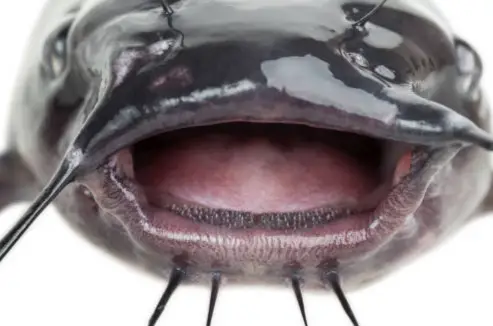Helpful Guides on each Category

catfish barb sting – let’s talk about those pesky little pricks that can ruin a perfectly good day out on the water. If you’ve ever been stung by one of these slimy critters, you know that it’s no laughing matter.
But that doesn’t mean we can’t approach the topic with a bit of playful curiosity!
So, what exactly happens when a catfish barb gets you? Well, first off, you’re likely to feel a sharp pain and a burning sensation around the area of the sting. But that’s just the beginning. Depending on how severe the Catfish sting is, you will see some effects, from mild irritation to full-blown allergic reactions.
But don’t worry, folks – we’re here to help. In this blog post, we’ll touch on everything you need to know about catfish barb stings. Then, we’ll discuss how to treat the stings, prevent them, and what to do if you have an allergic reaction.
For you: 5 Common Catfish Diseases. Quick Effective Treatment and Care Guide.
What are the barbs on a catfish? and how they can cause injury

The barbs on a catfish are long, thin structures that are usually located on the dorsal and pectoral fins of the fish, as well as on the operculum (gill cover). These barbs are composed of tough, fibrous material and are covered with tiny, backwards-facing spines.
When a catfish feels threatened, it can extend its barbs and use them to defend itself. The barbs are very sharp and can easily pierce the skin, causing injury and pain. Once the barb has penetrated the skin, the backwards-facing spines prevent it from being easily removed, causing additional pain and discomfort.
Also, the barbs on a catfish can also release venom into the wound. This venom is produced by glands located at the base of the barbs and can cause symptoms such as swelling, redness, pain, and even systemic effects such as fever, chills, and weakness.
Read Also: 33+ Best Catfish Bait (Artificial, Homemade). Attractive and Irresistible.
Do all catfish have barbs?
Not all catfish specie have barbs. The presence of barbs in catfishes is a characteristic feature of their family, Siluridae, which includes many species of catfishes.
Siluridae is commonly known as the “true catfishes” or “naked catfishes” and are identified by the presence of four pairs of barbels on the head, in addition to the absence of scales and adipose fins.
However, there are many other families of catfishes that do not possess barbs, including the Auchenipteridae, Aspredinidae, Trichomycteridae, and others. These catfishes have different body features, and some may have other specialized features to help them adapt to their environments, such as modified fins or elongated body shapes.
People wrongly assume that all catfish possess barbs. The presence or absence of barbs is a characteristic feature that varies among different families of catfishes.
What Happens If You Get Stung by a Catfish Barb?

When a catfish barb pierces your skin, it can cause immediate pain and bleeding. The barb is covered in a layer of slime that contains bacteria, which can cause an infection if it enters your bloodstream.
You also may experience swelling, redness, and tenderness at the site of the sting. If the barb breaks off in your skin, it can cause additional complications.
A catfish barbs sting is very painful and has physical effects like swelling and bleeding. The sting can occur when a catfish, usually found in freshwater, uses its sharp and spiny barbs to defend itself against predators or threats.
The immediate symptoms of a catfish barb sting may include intense pain at the site of the injury, as well as swelling and bleeding. In some cases, the sting may cause an allergic reaction, which can lead to additional symptoms such as itching, redness, and difficulty breathing.
Complications from a catfish barb sting can arise if the injury is not properly treated. Infection is a common risk, particularly if the sting occurs in dirty water or if the wound is not cleaned and disinfected promptly.
How Many Barbs Do Catfish Have?
Catfish have a varying number of barbs depending on the species. Most catfish species possess multiple barbels, which are fleshy, whisker-like projections located around their mouths.
These barbels, often referred to as “whiskers,” aid catfish in locating food and navigating their surroundings.
While the specific number of barbels differs, it is common for catfish to have 3 to 4 pairs of barbels, making a total of six or eight barbels.
How long does catfish sting pain last?
The duration of catfish sting pain can vary depending on the severity of the injury and the individual’s pain tolerance.
Generally, the pain from a catfish sting can last anywhere from a few hours to several days. However, in some cases, the pain can persist for weeks or even months.
What to do when catfish barbs you? Treatment for Catfish Barb Stings

To alleviate the pain from a catfish sting, it is recommended to clean the wound thoroughly, apply a cold compress or ice pack to the affected area, and take over-the-counter pain relievers such as ibuprofen or acetaminophen.
First Aid for a Catfish Barb Sting
- Remove the barb: If the barb is still in the skin, carefully remove it with tweezers or a needle. Be sure to avoid squeezing the area around the wound, as this can cause more venom to be released.
- Clean the wound: Wash the wound with soap and water to remove any dirt or debris. If available, you can also use an antiseptic solution or wipes to clean the wound.
- Apply pressure: Use a clean cloth or bandage to apply pressure to the wound and stop any bleeding.
- Apply a cold compress: Place a cold compress or ice pack on the affected area to help reduce pain and swelling.
How to Treat a Catfish Barb Sting. Medications
- Over-the-counter pain relievers: Over-the-counter pain relievers such as acetaminophen or ibuprofen can help alleviate pain and reduce inflammation.
- Antihistamines: If you experience an allergic reaction to the sting, an antihistamine such as Benadryl may help reduce symptoms such as itching and swelling.
- Antibiotics: If the wound becomes infected, your doctor may prescribe antibiotics to help clear the infection.
When to Seek Medical Attention for a Catfish Barb Sting.
In most cases, a catfish barb sting is not a medical emergency and can be treated with first aid measures. However, there are situations where it is important to seek medical attention.
Here are some signs that indicate you should seek medical help after a catfish barb sting:
- Allergic reaction: If you experience an allergic reaction after being stung by a catfish, such as hives, difficulty breathing, or swelling of the face, lips, tongue, or throat, seek medical attention immediately. This can be a sign of a severe allergic reaction that requires prompt treatment.
- Infection: If the wound becomes infected, you may experience symptoms such as redness, warmth, swelling, pus, or a fever. Seek medical attention if you suspect an infection, as it may require antibiotics or other medical treatment.
- Excessive bleeding: If the wound is bleeding heavily and does not stop after applying pressure for several minutes, seek medical attention.
- Severe pain: If you experience severe or persistent pain after being stung, seek medical attention. Your doctor may prescribe pain medication or other treatments to manage your symptoms.
- Difficulty removing the barb: If the barb has broken off in the wound and you are unable to remove it, seek medical attention. Attempting to remove the barb yourself can cause further damage and increase the risk of infection.
Symptoms of a Catfish Barb Sting Injury

The symptoms of a catfish barb injury can vary depending on the severity of the injury and whether an infection or allergic reaction occurs. Here are some common symptoms to look out for:
- Pain: A catfish barb injury can be very painful, and the pain may be intense and throbbing.
- Swelling: The affected area may become swollen and tender to the touch.
- Bleeding: The wound may bleed, and in some cases, the bleeding may be significant.
- Redness: The skin around the wound may become red and inflamed.
- Itching: Some people may experience itching or a burning sensation at the site of the injury.
- Allergic reaction: In some cases, an allergic reaction may occur, causing symptoms such as hives, difficulty breathing, or swelling of the face, lips, tongue, or throat.
- Infection: If the wound is not properly cleaned and treated, it may become infected. Signs of infection may include redness, warmth, swelling, pus, or a fever.
How to Handle a Live Catfish Without Getting Stung
Catfish have several barbs located on various parts of their body, including their dorsal fin, pectoral fins, and spines on their operculum (gill cover). These barbs are sharp and can deliver a painful sting if touched.
The best way to avoid getting stung by a catfish barb is to handle the fish properly with a pair of hand gloves. When you catch a catfish, use a pair of pliers to hold onto the fish’s mouth and gently remove the hook.
If you need to handle the fish further, use hand gloves or a towel to protect your hands. Never grab a catfish by its body or attempt to remove the catfish’s barbs with your hands.
Tips for Safely Handling Catfish to Avoid Barbs Sting
- Wear protective gear: To avoid getting stung by a catfish, wear protective gloves and clothing that covers your arms and hands. Thick, heavy-duty gloves are recommended.
- Use pliers: When handling catfish, use pliers to grip the fish and avoid touching the barbs directly.
- Hold the fish firmly: When picking up a catfish, be sure to hold it firmly and avoid letting it flop around. This can cause the fish to thrash and potentially sting you or others nearby.
- Remove the barbs: Some fishermen choose to remove the barbs from their catfish to avoid getting stung. This should only be done by a professional or experienced fisherman, as it requires special tools and knowledge of the fish’s anatomy.
Precautions for Cleaning and Preparing Catfish
- Use a sharp knife: When cleaning and preparing catfish, use a sharp knife to avoid damaging the fish and potentially releasing venom.
- Cut away from yourself: Always cut away from yourself when cleaning catfish to avoid accidentally cutting yourself.
- Wear gloves: Wear protective gloves when handling catfish during the cleaning and preparation process.
- Use a cutting board: Use a clean cutting board or surface to prepare catfish and avoid cross-contamination with other foods.
Can catfish Barbs sting make you sick?
While the injury from a catfish barbs or spine itself is painful, it is unlikely to make you seriously sick on its own. However, if the wound becomes infected due to improper care or if there are any complications related to the injury, it could lead to more significant health issues.
Catfish do not possess stingers like some other fish, such as stingrays or scorpionfish. But, catfish have whiskers and spines, especially in their dorsal and pectoral fins, that sting if not handled well.
These spines are sharp and can puncture the skin, leading to pain, swelling, and even infection if not treated properly.
Myths and Facts About Catfish Barb Sting
Myth 1. All catfish have venomous barbs.
Correct Fact
Only some species of catfish have venomous barbs, including the North American channel catfish and the South American Pictus catfish. Most other species of catfish do not have venomous barbs.
Myth 2. You should urinate on a catfish barb wound to alleviate the pain.
Correct Fact
This is a common myth, but it is not true. Urinating on a catfish barb wound will not alleviate the pain and can actually make the wound more susceptible to infection. It is important to follow appropriate first aid measures, such as cleaning the wound and applying a cold compress, to manage your symptoms.
Myth 3. You should remove a catfish barb by squeezing it or using tweezers.
Correct Fact
This is not recommended. Squeezing the barb or using tweezers can cause it to break off or release more venom into the wound, increasing the risk of infection and other complications. Instead, you should use a pair of pliers or other tools to carefully remove the barb as close to the skin as possible.
Myth 4. Soak catfish barb wound in hot water.
Correct Fact
Soaking a catfish barb wound in hot water can make the pain and swelling worse, as it can cause the venom to spread more quickly. Instead, you should rinse the wound with cool water and apply a cold compress to alleviate your symptoms.
Myth 5. You should cut the wound to let the venom out.
Correct Fact
This is not recommended. Cutting the wound can cause more damage and increase the risk of infection. Instead, you should clean the wound and apply a cold compress to manage your symptoms.
FAQs on Catfish Barb
From encounter, the genus Plotosus, commonly known as the toxic catfish or puffer catfish has been tagged by many as the most poisonous catfish. Among the various species in this genus, the most notorious is Plotosus lineatus, also called the estuarine catfish or reef stonefish. Its venomous spines cause severe pain and injury.
Not all catfish spines are poisonous, but some species do have venomous spines that can cause pain and discomfort if they puncture the skin.
The venomous spines of catfish are mostly in the families Ariidae, Plotosidae, and Bagridae.
Although they cause painful injuries and introduce bacterial infections if not handled properly, catfish barbs are not on their own poisonous. The misconception about ‘catfish barbs being poisonous‘ stems from the fact that some catfish species have venom glands associated with their barbs, which cause discomfort and other symptoms.




